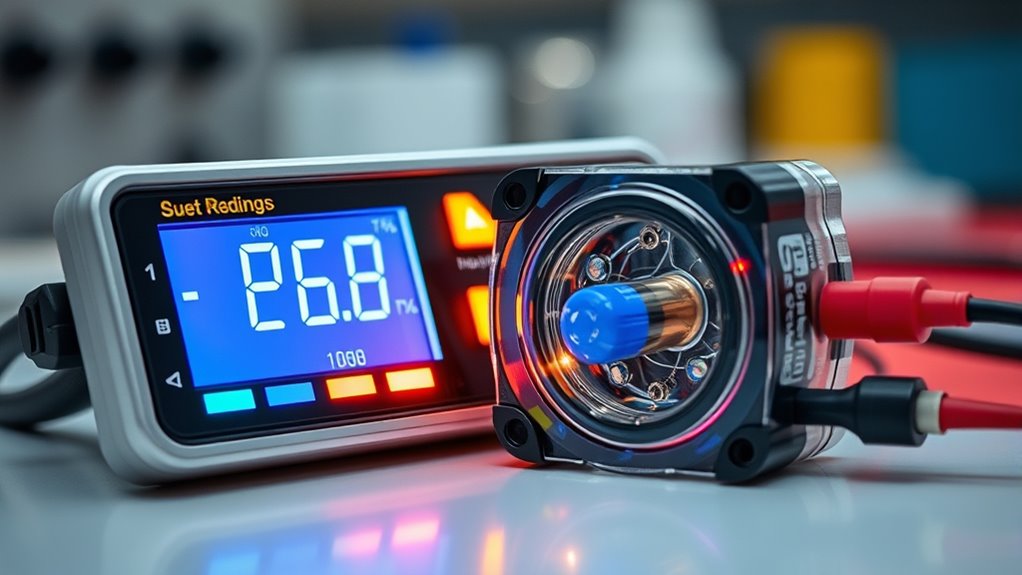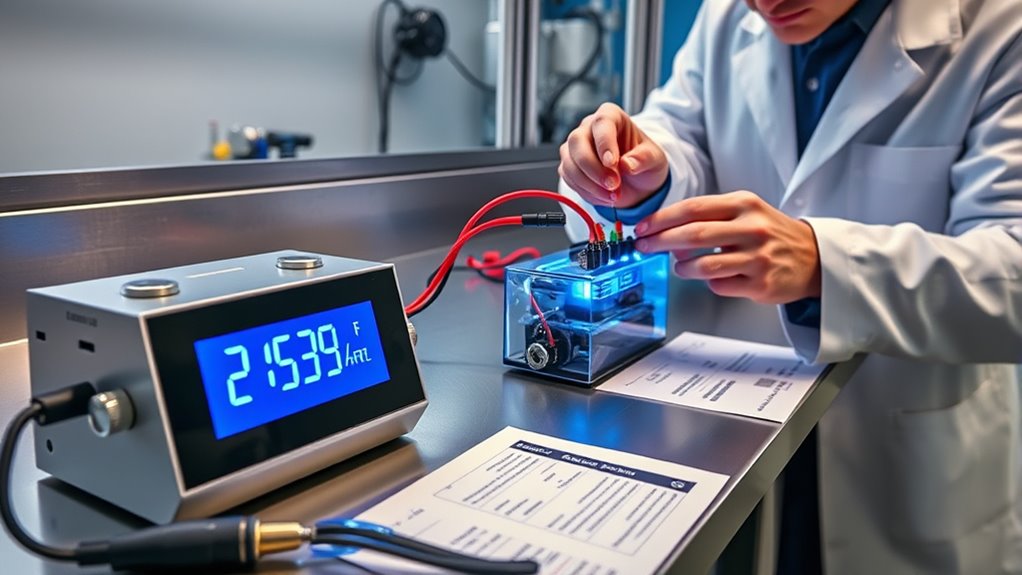Calculating the C-rate is simple once you understand the basics. Just divide the current you’re applying (in amps) by your battery’s capacity (in amp-hours). For example, 25A on a 50Ah battery equals a 0.5C rate. Knowing this assists you stay within safe limits, extend battery life, and optimize performance. Keep going, and you’ll discover more tips to master battery management and ensure safe charging every time.
Key Takeaways
- Understand that C-rate equals current divided by battery capacity, simplifying charge/discharge rate calculations.
- Use the formula: C-rate = Current (A) / Capacity (Ah), for quick and accurate results.
- Recognize that 1C equals charging/discharging at a current equal to the battery’s capacity.
- Avoid exceeding manufacturer-recommended C-rates to prevent damage and ensure safety.
- Applying proper C-rate calculations optimizes battery lifespan, performance, and safety without guesswork.

Understanding C-rate calculations is fundamental for evaluating how quickly a battery can charge or discharge relative to its capacity. When you grasp this concept, you gain better control over battery performance and safety, especially during charging and discharging cycles. The C-rate essentially tells you how fast a battery is being charged or used, which directly impacts battery safety and longevity. For instance, charging a battery at a high C-rate might speed up the process but can also increase the risk of overheating or damage if not managed properly. Conversely, charging at a low C-rate ensures safety and prolongs battery life but takes more time. Knowing how to calculate and interpret the C-rate allows you to develop proper charging protocols that maximize efficiency without compromising safety.
To put it simply, the C-rate is a measure of current relative to a battery’s capacity. If a battery has a capacity of 100 Ah (ampere-hours), a 1C charge or discharge rate means you’re applying 100 amps. A 0.5C rate would be 50 amps, and a 2C rate would be 200 amps. This relationship helps you easily understand how fast the battery is being charged or discharged compared to its total capacity. When you plan your charging protocols, you need to take into account the C-rate to avoid pushing the battery beyond safe limits. For example, charging at a rate higher than the manufacturer’s recommended C-rate can lead to thermal runaway, degradation, or even catastrophic failure. That’s why understanding and calculating the C-rate is crucial for maintaining battery safety and ensuring ideal performance over its lifespan.
In practical terms, calculating the C-rate is straightforward. You divide the current (in amps) by the battery’s capacity (in amp-hours). If you’re charging a 50 Ah battery with a current of 25 amps, then the C-rate is 0.5C. This simple calculation provides immediate insight into whether you’re adhering to safe charging protocols. When you operate within recommended C-rates, you reduce the risk of damaging the battery and ensure it operates reliably. Many batteries and chargers have built-in safeguards, but knowing the C-rate allows you to customize your approach for specific applications—whether you’re designing an electric vehicle, a solar energy system, or a portable device. Proper understanding and application of C-rate calculations help you implement safe charging practices, extend battery life, and maximize efficiency, giving you confidence in managing your batteries without guesswork. Additionally, understanding the Honda Tuning concepts can help optimize related systems like electric vehicle batteries or hybrid setups for better performance and safety.
Frequently Asked Questions
How Do C-Rates Affect Battery Lifespan?
Understanding how C-rates affect battery lifespan helps you optimize performance. Higher C-rates cause faster battery degradation because they stress the battery, reducing its overall lifespan. This impacts charge efficiency, making charging less effective over time. By managing C-rates and avoiding rapid charging, you can extend your battery’s life, ensuring it stays healthier longer and maintains better performance throughout its usage.
Can C-Rate Calculations Vary With Temperature Changes?
Temperature effects can influence C-rate variations considerably. As temperature changes, your battery’s internal resistance shifts, causing the same C-rate to behave differently. At higher temperatures, you might notice increased current flow, leading to faster charging or discharging. Conversely, lower temperatures can reduce C-rate efficiency, potentially harming your battery’s lifespan. So, always consider temperature effects when calculating or applying C-rates to guarantee best battery performance and longevity.
What Safety Precautions Are Necessary During High C-Rate Charging?
Charging a battery at high C-rates is like pushing a tightrope walker’s limits—you need balance and caution. Always prioritize thermal management to prevent overheating, and guarantee charger compatibility to avoid voltage spikes. Use proper cooling systems and monitor temperature closely. Follow manufacturer guidelines and never leave the battery unattended during high C-rate charging. These precautions help protect both your battery and yourself from potential hazards.
How to Choose the Right C-Rate for Specific Applications?
When choosing the right C-rate for your application, consider your battery chemistry and the specific charging protocols recommended. You need a C-rate that balances fast charging with battery longevity; too high can cause overheating or damage, while too low prolongs charge time. Always follow manufacturer guidelines, and test different rates if necessary, to find the best balance for safety, performance, and battery health.
Are There Industry Standards for C-Rate Testing?
Think of industry standards for C-rate testing like a compass guiding sailors through rough seas. You’ll find that industry benchmarks and testing protocols vary by application and region. These standards guarantee consistency, safety, and performance. It’s important to consult relevant organizations, like ASTM or IEC, to follow their recommended testing procedures. This way, you can confidently compare results and optimize your battery performance without guesswork.
Conclusion
Now that you know how simple c-rate calculations are, why guess or rely on guesswork anymore? With these easy steps, you can confidently evaluate battery performance and guarantee safety. Isn’t it time you took control of your battery management? Making informed decisions becomes effortless when you understand the basics. So, next time you’re faced with a c-rate question, remember—precision and confidence are just a calculation away. Ready to become a c-rate pro?










